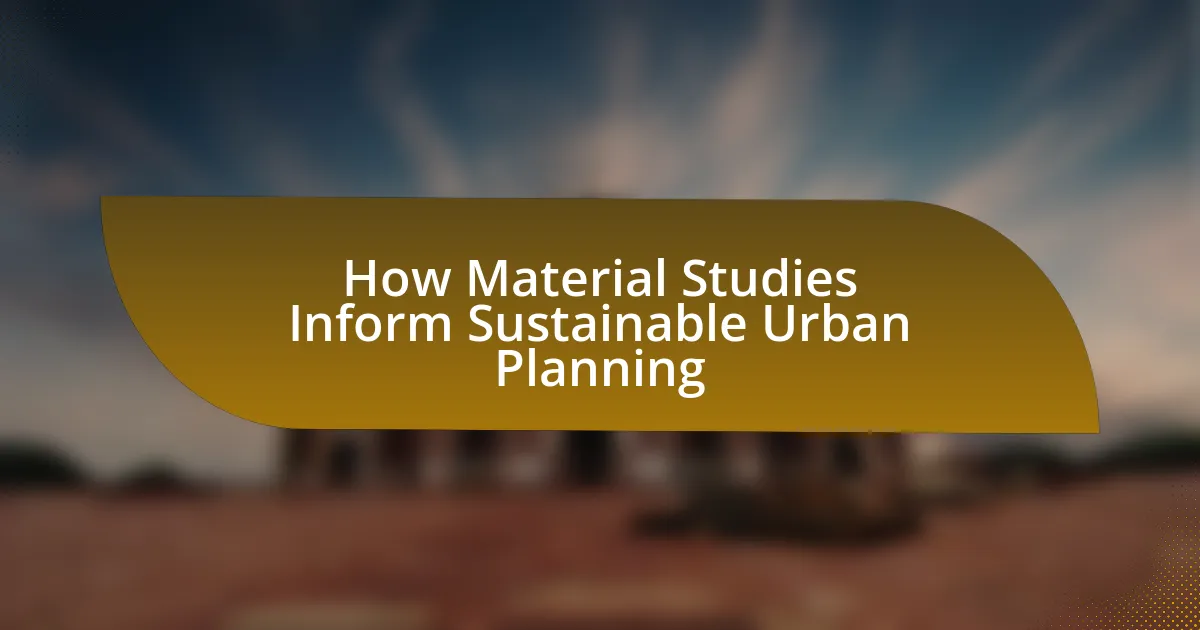Material studies play a crucial role in sustainable urban planning by offering insights into the environmental impact, durability, and lifecycle of construction materials. These studies guide urban planners in selecting materials that minimize carbon footprints, enhance energy efficiency, and promote resource conservation. Key principles include examining materiality, sustainability, and socio-cultural implications, which collectively inform design decisions and improve urban resilience. Lifecycle assessments are essential for evaluating the environmental impacts of materials, while the integration of renewable and recycled materials supports sustainability goals. The article explores the significance of material studies in shaping effective urban planning strategies, addressing challenges, and highlighting future trends in material innovation.

How do material studies contribute to sustainable urban planning?
Material studies contribute to sustainable urban planning by providing insights into the environmental impact, durability, and lifecycle of construction materials. These studies enable urban planners to select materials that minimize carbon footprints, enhance energy efficiency, and promote resource conservation. For instance, research indicates that using recycled materials can reduce waste and lower greenhouse gas emissions, aligning with sustainability goals. Additionally, material studies often reveal the performance characteristics of various materials under different environmental conditions, which helps in designing resilient urban infrastructures. This evidence-based approach ensures that urban development is not only functional but also environmentally responsible.
What are the key principles of material studies in urban contexts?
The key principles of material studies in urban contexts include the examination of materiality, sustainability, and socio-cultural implications. Materiality focuses on understanding the physical properties and behaviors of materials used in urban environments, which directly influence design and functionality. Sustainability emphasizes the need for materials that minimize environmental impact, promote resource efficiency, and support long-term ecological balance. Socio-cultural implications address how materials affect social interactions, community identity, and cultural heritage within urban settings. These principles are validated by research indicating that thoughtful material selection can enhance urban resilience and contribute to sustainable development goals.
How do material properties influence urban design decisions?
Material properties significantly influence urban design decisions by determining the functionality, sustainability, and aesthetic appeal of structures and public spaces. For instance, the thermal mass of materials like concrete can enhance energy efficiency in buildings, reducing heating and cooling costs, which is crucial for sustainable urban planning. Additionally, the durability of materials affects maintenance costs and longevity, impacting long-term urban resilience. Research indicates that using locally sourced materials can lower carbon footprints and support local economies, further aligning with sustainable practices. Thus, understanding material properties is essential for making informed urban design choices that promote environmental sustainability and community well-being.
What role do lifecycle assessments play in material selection?
Lifecycle assessments (LCAs) play a critical role in material selection by evaluating the environmental impacts of materials throughout their entire lifecycle, from extraction to disposal. This comprehensive analysis enables decision-makers to identify materials that minimize negative environmental effects, such as carbon emissions and resource depletion. For instance, a study published in the Journal of Cleaner Production found that using LCAs can lead to a 30% reduction in greenhouse gas emissions by selecting more sustainable materials. Thus, LCAs provide essential data that guides the selection of materials that align with sustainability goals in urban planning.
Why is sustainability important in urban planning?
Sustainability is crucial in urban planning because it ensures the long-term viability of cities by balancing environmental, social, and economic needs. Sustainable urban planning promotes efficient resource use, reduces waste, and minimizes environmental impact, which is essential as urban populations continue to grow. For instance, according to the United Nations, by 2050, 68% of the world’s population is projected to live in urban areas, increasing the demand for sustainable infrastructure and services. Implementing sustainable practices in urban planning can lead to improved air quality, reduced greenhouse gas emissions, and enhanced quality of life for residents, thereby validating the importance of sustainability in shaping resilient urban environments.
How does urbanization impact environmental sustainability?
Urbanization negatively impacts environmental sustainability by increasing resource consumption and waste generation. As urban areas expand, they often lead to habitat destruction, increased pollution, and higher carbon emissions. For instance, the United Nations reports that urban areas account for approximately 70% of global greenhouse gas emissions, primarily due to transportation, energy use, and industrial activities. Additionally, urbanization can strain water resources, with cities consuming over 80% of the world’s freshwater supply, exacerbating issues related to water scarcity and quality. These factors collectively undermine the ecological balance necessary for sustainable development.
What are the social implications of sustainable urban planning?
Sustainable urban planning has significant social implications, including enhanced community well-being, increased social equity, and improved public health. By prioritizing green spaces, mixed-use developments, and accessible public transportation, sustainable urban planning fosters social interaction and community cohesion. Research indicates that neighborhoods designed with sustainability in mind can reduce social isolation and promote inclusivity, as seen in cities like Copenhagen, where integrated cycling infrastructure has led to higher community engagement. Furthermore, sustainable practices can mitigate environmental injustices, ensuring that marginalized communities have access to clean air, safe public spaces, and essential services, thereby promoting social equity. Studies show that urban areas implementing sustainable planning strategies experience lower rates of chronic diseases, highlighting the direct link between urban design and public health outcomes.

What types of materials are most relevant for sustainable urban planning?
Sustainable urban planning primarily relies on materials that are renewable, recyclable, and have low environmental impact. Key materials include bamboo, which is fast-growing and strong; recycled steel, which reduces waste and energy consumption; and rammed earth, known for its thermal mass and sustainability. Studies show that using these materials can significantly lower carbon footprints; for instance, bamboo can sequester carbon dioxide during its growth, while recycled steel can save up to 74% of the energy required to produce new steel. These materials not only contribute to environmental sustainability but also enhance the resilience and livability of urban spaces.
How do renewable materials differ from traditional materials?
Renewable materials differ from traditional materials primarily in their source and sustainability. Renewable materials are derived from natural resources that can be replenished over time, such as bamboo, cork, and recycled plastics, whereas traditional materials often include finite resources like fossil fuels, metals, and non-renewable minerals. The use of renewable materials contributes to reduced environmental impact, as they typically require less energy to produce and can lead to lower carbon emissions. For instance, the production of bamboo generates significantly less carbon dioxide compared to concrete, which is responsible for approximately 8% of global CO2 emissions. This distinction highlights the importance of renewable materials in promoting sustainable urban planning practices.
What are examples of renewable materials used in urban projects?
Examples of renewable materials used in urban projects include bamboo, reclaimed wood, recycled metal, and natural fibers such as hemp and jute. Bamboo is known for its rapid growth and strength, making it a sustainable choice for construction. Reclaimed wood reduces waste and preserves the character of existing structures. Recycled metal, often sourced from old buildings or vehicles, minimizes the need for new mining. Natural fibers like hemp and jute are biodegradable and can be used in insulation and composite materials. These materials contribute to sustainability by reducing environmental impact and promoting resource efficiency in urban development.
How do recycled materials contribute to sustainability?
Recycled materials contribute to sustainability by reducing the demand for virgin resources, thereby conserving natural habitats and minimizing environmental degradation. The recycling process often requires less energy compared to producing new materials; for instance, recycling aluminum saves up to 95% of the energy needed to create new aluminum from bauxite ore. Additionally, using recycled materials decreases landfill waste, which is crucial as landfills are a significant source of greenhouse gas emissions. According to the Environmental Protection Agency, recycling and composting prevented the release of approximately 186 million metric tons of carbon dioxide equivalent into the air in 2013, highlighting the positive impact of recycling on climate change mitigation.
What innovative materials are emerging in urban planning?
Innovative materials emerging in urban planning include self-healing concrete, recycled plastics, and bio-based materials. Self-healing concrete utilizes encapsulated healing agents that activate upon cracking, significantly extending the lifespan of structures and reducing maintenance costs. Research by the University of Cambridge demonstrated that this material can repair itself, leading to a reduction in the need for repairs by up to 50%. Recycled plastics are being repurposed into construction materials, which not only diverts waste from landfills but also reduces the carbon footprint associated with traditional materials. A study by the Ellen MacArthur Foundation highlighted that using recycled plastics in construction can lower greenhouse gas emissions by 30%. Bio-based materials, such as mycelium and bamboo, offer sustainable alternatives that are renewable and have lower environmental impacts. The use of mycelium in construction has been shown to have a carbon-negative footprint, as reported in research published in the journal “Materials Today.” These innovative materials are reshaping urban planning by promoting sustainability and resilience in built environments.
How do smart materials enhance urban infrastructure?
Smart materials enhance urban infrastructure by providing adaptive responses to environmental changes, improving durability, and optimizing resource use. These materials can change properties in response to stimuli such as temperature, moisture, or stress, which allows for structures that can self-repair or adjust to varying conditions. For instance, shape-memory alloys can return to a predetermined shape after deformation, enhancing the longevity of bridges and buildings. Additionally, smart materials like piezoelectric sensors can monitor structural health in real-time, allowing for proactive maintenance and reducing costs associated with repairs. Studies have shown that integrating smart materials into urban infrastructure can lead to a reduction in energy consumption by up to 30%, demonstrating their effectiveness in promoting sustainability in urban planning.
What are the benefits of using biophilic materials in urban spaces?
The benefits of using biophilic materials in urban spaces include enhanced well-being, improved air quality, and increased biodiversity. Biophilic materials, such as natural wood, stone, and living plants, contribute to mental health by reducing stress and promoting relaxation, as evidenced by studies showing that exposure to natural elements can lower cortisol levels. Additionally, these materials can improve air quality by filtering pollutants and increasing oxygen levels, which is crucial in densely populated urban areas. Furthermore, incorporating biophilic materials supports biodiversity by creating habitats for various species, thereby fostering ecological balance within urban environments.

How can urban planners effectively integrate material studies into their projects?
Urban planners can effectively integrate material studies into their projects by utilizing research on sustainable materials to inform design choices and construction methods. This integration allows planners to select materials that enhance environmental performance, reduce carbon footprints, and improve the longevity of urban infrastructure. For instance, studies have shown that using recycled materials can significantly lower resource consumption and waste generation, as evidenced by the 2018 report from the Ellen MacArthur Foundation, which highlights that circular economy practices in construction can reduce material costs by up to 30%. By incorporating findings from material studies, urban planners can create more resilient and sustainable urban environments.
What strategies can be employed for effective material selection?
Effective material selection can be achieved through strategies such as life cycle assessment (LCA), performance-based criteria, and sustainability certifications. Life cycle assessment evaluates the environmental impacts of materials from extraction to disposal, enabling informed choices that minimize ecological footprints. Performance-based criteria focus on the specific functional requirements of materials, ensuring they meet durability, safety, and aesthetic standards. Sustainability certifications, such as LEED or BREEAM, provide verified benchmarks for materials that adhere to environmental and social responsibility standards, guiding decision-makers toward sustainable options. These strategies collectively enhance the effectiveness of material selection in sustainable urban planning.
How can collaboration with material scientists improve urban planning outcomes?
Collaboration with material scientists can significantly enhance urban planning outcomes by integrating advanced materials that improve sustainability, durability, and functionality of urban infrastructure. For instance, the use of innovative materials such as self-healing concrete and energy-efficient building materials can reduce maintenance costs and environmental impact. Research indicates that cities employing such materials can achieve up to a 30% reduction in energy consumption and a 50% decrease in maintenance needs over time. This collaboration ensures that urban planners have access to the latest material innovations, enabling them to design more resilient and sustainable urban environments.
What tools and resources are available for urban planners to assess materials?
Urban planners can utilize a variety of tools and resources to assess materials, including software applications, databases, and guidelines. Tools such as Building Information Modeling (BIM) software enable planners to analyze material properties and performance in design simulations. Databases like the Material Data Center provide comprehensive information on material specifications, sustainability ratings, and lifecycle assessments. Additionally, guidelines from organizations such as the American Society of Civil Engineers (ASCE) offer best practices for material selection based on environmental impact and durability. These resources collectively support informed decision-making in sustainable urban planning.
What best practices should urban planners follow when considering materials?
Urban planners should prioritize sustainability, durability, and local sourcing when selecting materials. Sustainable materials reduce environmental impact, while durable materials ensure longevity and lower maintenance costs. Local sourcing minimizes transportation emissions and supports the local economy. For instance, using recycled materials can significantly decrease resource consumption; a study by the National Recycling Coalition found that recycling one ton of concrete saves 1,360 gallons of water and 900 kilograms of CO2 emissions. Additionally, planners should consider the lifecycle assessment of materials to evaluate their overall environmental impact, ensuring that choices align with sustainable urban development goals.
How can planners ensure community engagement in material selection processes?
Planners can ensure community engagement in material selection processes by actively involving community members through workshops, surveys, and public meetings. These methods facilitate direct input from residents, allowing them to express preferences and concerns regarding material choices. Research indicates that projects incorporating community feedback, such as the “Community Engagement in Urban Planning” study by the American Planning Association, show increased satisfaction and better alignment with community needs. Engaging the community not only fosters transparency but also enhances the likelihood of successful implementation of sustainable materials that reflect local values and priorities.
What are common challenges faced in integrating material studies into urban planning?
Common challenges faced in integrating material studies into urban planning include a lack of interdisciplinary collaboration, insufficient data on material performance, and regulatory constraints. Interdisciplinary collaboration is often limited, as urban planners, architects, and material scientists may not effectively communicate or share knowledge, leading to suboptimal material choices. Additionally, there is often insufficient data on the long-term performance and environmental impact of materials, making it difficult for planners to make informed decisions. Regulatory constraints can also hinder the adoption of innovative materials, as existing codes and standards may not accommodate new findings from material studies. These challenges collectively impede the effective integration of material studies into urban planning, ultimately affecting sustainability outcomes.
What are the future trends in material studies for sustainable urban planning?
Future trends in material studies for sustainable urban planning include the development of bio-based materials, smart materials, and circular economy practices. Bio-based materials, such as bioplastics and natural fibers, are gaining traction due to their lower environmental impact and renewability. Smart materials, which can adapt to environmental changes, enhance energy efficiency and user comfort in urban settings. Circular economy practices focus on reusing and recycling materials to minimize waste, promoting sustainability in urban development. Research indicates that integrating these materials can significantly reduce carbon footprints and resource consumption in urban environments, aligning with global sustainability goals.
How might advancements in technology influence material choices in urban settings?
Advancements in technology significantly influence material choices in urban settings by enabling the development and application of innovative, sustainable materials. For instance, the rise of smart materials, which can adapt to environmental changes, allows urban planners to select options that enhance energy efficiency and reduce waste. Additionally, technologies such as 3D printing facilitate the use of locally sourced materials, minimizing transportation emissions and costs. Research indicates that the integration of recycled materials in construction, driven by technological advancements, can reduce the carbon footprint of urban development by up to 30%. These technological innovations not only improve the performance and sustainability of materials but also align with the goals of sustainable urban planning.
What role will policy play in shaping material use in urban planning?
Policy will play a critical role in shaping material use in urban planning by establishing regulations and guidelines that promote sustainable practices. These policies can incentivize the use of eco-friendly materials, mandate recycling and waste reduction, and set standards for energy efficiency in construction. For instance, the implementation of building codes that require the use of sustainable materials can significantly reduce the carbon footprint of urban developments. Additionally, policies that support research and development in material science can lead to innovative solutions that enhance the sustainability of urban environments.
